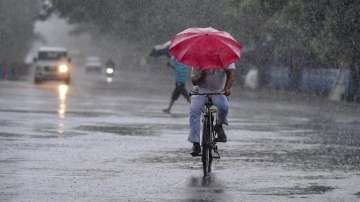Early onset of monsoon triggers rainfall in most parts of India as locust attack fears increase
The early onset of monsoon triggered moderate-to-heavy rainfall across India on Saturday, barring a few places on the west coast, providing a breeding ground for the crop-threatening locusts that invaded the country via Pakistan towards the end of April.
The early onset of monsoon triggered moderate-to-heavy rainfall across India on Saturday, barring a few places on the west coast, providing a breeding ground for the crop-threatening locusts that invaded the country via Pakistan towards the end of April.
Several areas in Rajasthan, Haryana and Uttar Pradesh reported locust attacks as authorities struggled to chase them away or kill them by spraying pesticides.
The short-horn hoppers even descended on Gurgaon near the national capital, where the humidity levels oscillated between 49 and 82 per cent. The Delhi government has put all its districts on alert as a small swarm covering 1 sq km can consume the food 35,000 people can eat in one day.
Experts say the desert locusts usually arrive in India with the onset of the southwest monsoon, a wind system blowing from the Arabian Sea to the mainland, aiding the movement of the hoppers from Africa and West Asia. The humid weather and intermittent rainfall provide a fertile ground to the pink immature adults to multiply very rapidly.
Several parts of north India, including Bihar, Uttar Pradesh, Haryana and Punjab have been witnessing moderate-to-heavy rainfall for the past few days and this possibly has led to increased locust movement and breeding.
On Saturday, Delhi Environment Minister Gopal Rai chaired an emergency meeting with senior officials after the locusts reached the Asola Bhatti area in South Delhi.
Officials said the insects were now headed to Palwal and Faridabad and from there they could enter UP, which is already battling a number of swarms in several of its districts including Jhansi, Chitrakoot, Allahabad, Pratapgarh and Bhadohi.
A swarm has also attacked the UP agriculture minister Surya Pratap Shahi's 's home district Deoria. Shahi said the districts where the swarms will take shelter, chemicals will be sprayed on them and they will be killed. Other districts have been alerted, he added.
The Gautam Buddh Nagar administration on UP's western border with Delhi has set up a helpline – 0120 2977986 - to assist the general public against the locust menace, which has been declared as a disaster by the state government.
The district, which also borders Haryana, has set up a task force and asked residents to chase the locusts away by making high-decibel sounds by beating drums, utensils; playing high-volume music, bursting crackers, and burning neem leaves. It also asked the people to spray chemicals during the night, when locusts rest on crops.
In Rajasthan, where the monsoon appears to have weakened after reaching on June 25, the weather department said not much rainfall is likely for next three-four days. The monsoon may pick up again and heavy rainfall is likely in Kota and Udaipur on June 30. Bikaner was the hottest place in the state with a maximum temperature of 41.8 degrees Celsius.
"For a month-and-a-half, there has been intermittent locust attacks in districts sharing a border with Pakistan. Operations are on to control them. Older swarms have been killed but new swarms are entering Rajasthan," said Deputy Director of Agriculture Department in Rajasthan B.R Kadwa.
The mercury neared the 40 degrees Celsius-mark in Delhi, just two days after monsoon clouds reached the city. However, UP witnessed heavy rainfall on Saturday and the weather department has said more rainfall is likely during the next three days.
Also, the Union Agriculture Ministry said more teams from Rajasthan have been deputed to help control the locust spread in Haryana and Uttar Pradesh. The control operations are underway in Rajasthan, Haryana and Uttar Pradesh, it added.
The Haryana government has issued a high alert after a swarm entered Rewari and Gurgaon. Officials asserted that all necessary measures have been taken, including deploying tractor-mounted spraying facilities.
Alarmed by the invasion of locusts, which settled on trees, rooftops and plants, many residents of Gurgaon shared videos from their high-rise perches.
